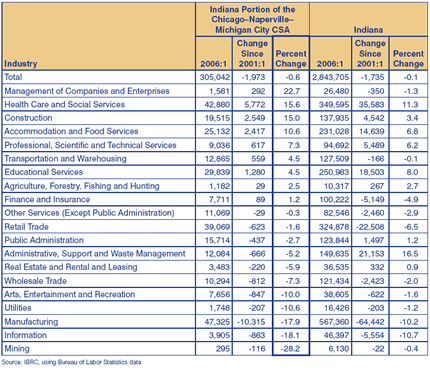The Chicago-Naperville-Michigan City CSA
This article is the first of seven with a focus on Indiana's mega metros, otherwise known as Combined Statistical Areas (CSAs). CSAs are groupings of federally defined metropolitan (metro) and/or micropolitan (micro) areas that, as the title suggests, combine these areas to “represent larger regions and reflect broader social and economic interactions.” (1)
The Chicago–Naperville–Michigan City CSA is made up of the Chicago–Naperville–Joliet metro, the Kankakee–Bradley (Illinois) metro, and the Michigan City–La Porte metro and spans three states (see Figure 1). For the purposes of this article, we will focus on the Indiana portion of the CSA, which includes the following five counties: Lake, Porter, LaPorte, Newton and Jasper.
Figure 1: Metros Included in the Chicago-Naperville-Michigan City CSA
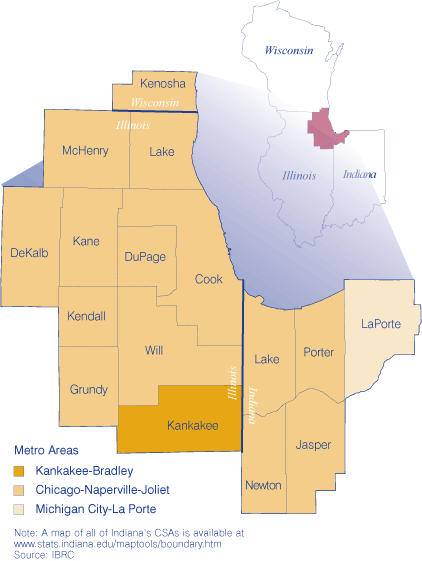
These five counties make up 12.9 percent of Indiana's 6.3 million residents, and 8.4 percent of the entire CSA's population. Gary is the largest city in the CSA, pushing a population of 99,000 people. The Hoosiers calling the Chicago–Naperville–Michigan City CSA home are more racially diverse than any of the other six CSAs and the state overall (see Figure 2).
Figure 2: Percent of Population in Each CSA by Race, 2005
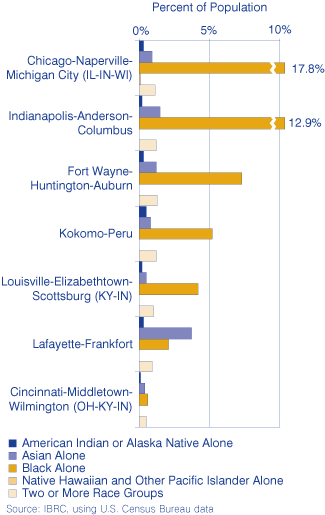
Employment
Jobs in the Indiana portion of the Chicago–Naperville–Michigan City CSA have taken a hit over the past five years, with losses of nearly 2,000 jobs from the first quarter of 2001 to 2006 (down 0.6 percent). Meanwhile, Indiana lost 0.1 percent of its jobs during that same time.
At the individual industry level, despite its losses of more than 10,300 jobs over the past five years, manufacturing remained the largest industry in the region, making up 15.5 percent of all jobs in 2006. Compare that to 20 percent of all jobs at the state level. Other than manufacturing, the health care and social services industry supplied the most jobs at both the regional and state levels, making up 14.1 percent and 12.3 percent of jobs, respectively (see Table 1).
Table 1: Change in Jobs in the Chicago-Naperville-Michigan City CSA, 2001:1 to 2006:1
Wages
Those working in the management of companies and enterprises industry in the Chicago–Naperville–Michigan City CSA didn't have much to complain about in terms of available jobs or the wages received. From 2001 to 2006, the CSA added 292 jobs and increased weekly wages by $745. This brought average weekly wages in the industry to $2,117, the only industry to pay average wages of more than $2,000 per week in any industry across any of Indiana's CSAs. The Fort Wayne-Huntington-Auburn CSA came closest, paying utility workers an average of $1,905 per week.
Accommodation and food services paid the least in the Chicago–Naperville–Michigan City CSA, averaging $213 per week in the first quarter of 2006, an increase of only $11 from five years earlier (see Figure 3). Overall, the Chicago–Naperville–Michigan City CSA increased average weekly wages by $94, only slightly better than Indiana's increase of $93 over the five-year span.
Figure 3: Average Weekly Wages in the Chicago-Naperville-Michigan City CSA, 2006:1
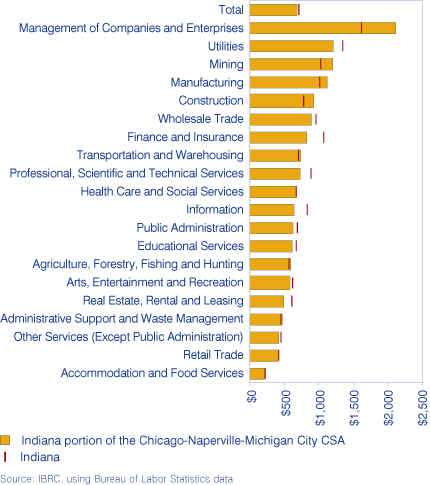
Commuting
There were just over 287,300 workers living and working in the Indiana portion of the Chicago–Naperville–Michigan City CSA in 2000, according to Census data. Another 6,527 came into the region from elsewhere in the state (see Figure 4). The Indiana portion of the CSA sent out a total of 64,625 workers, 83.2 percent of which traveled to the Illinois and Wisconsin portions of the CSA to work (11.8 percent traveled elsewhere within Indiana and 5.1 percent traveled out of state, but not anywhere within the CSA). (2)
Figure 4: Chicago-Naperville-Michigan City CSA Commuting from Indiana Portion, 2000
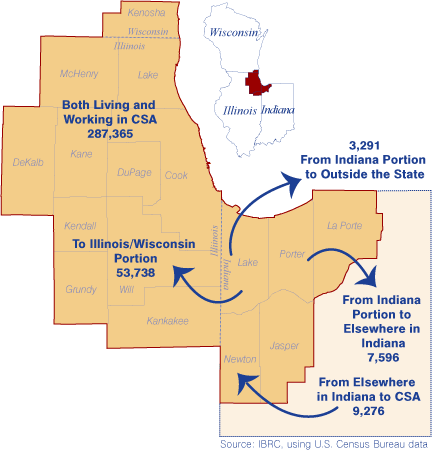
Notes
- U.S. Office of Management and Budget, available at www.whitehouse.gov/omb/
- These numbers do not add to 100 due to rounding.
Molly Manns, Research Associate
Indiana Business Research Center, Kelley School of Business, Indiana University

